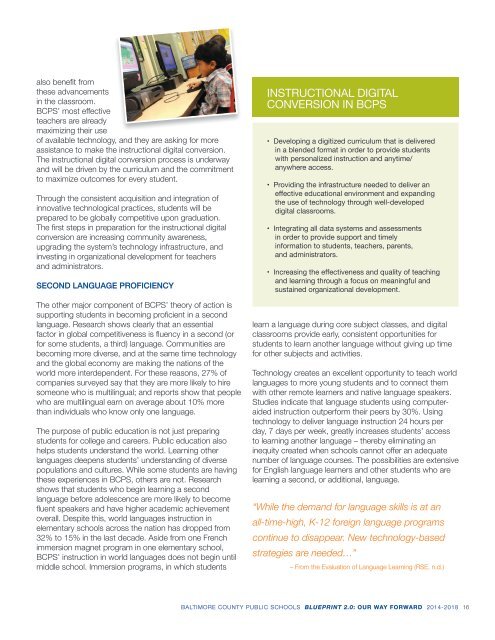BLUEPRINT 2.0 OUR WAY FORWARD
bcpsbrochure_final3
bcpsbrochure_final3
Create successful ePaper yourself
Turn your PDF publications into a flip-book with our unique Google optimized e-Paper software.
also benefit from<br />
these advancements<br />
in the classroom.<br />
BCPS’ most effective<br />
teachers are already<br />
maximizing their use<br />
of available technology, and they are asking for more<br />
assistance to make the instructional digital conversion.<br />
The instructional digital conversion process is underway<br />
and will be driven by the curriculum and the commitment<br />
to maximize outcomes for every student.<br />
Through the consistent acquisition and integration of<br />
innovative technological practices, students will be<br />
prepared to be globally competitive upon graduation.<br />
The first steps in preparation for the instructional digital<br />
conversion are increasing community awareness,<br />
upgrading the system’s technology infrastructure, and<br />
investing in organizational development for teachers<br />
and administrators.<br />
SECOND LANGUAGE PROFICIENCY<br />
The other major component of BCPS’ theory of action is<br />
supporting students in becoming proficient in a second<br />
language. Research shows clearly that an essential<br />
factor in global competitiveness is fluency in a second (or<br />
for some students, a third) language. Communities are<br />
becoming more diverse, and at the same time technology<br />
and the global economy are making the nations of the<br />
world more interdependent. For these reasons, 27% of<br />
companies surveyed say that they are more likely to hire<br />
someone who is multilingual; and reports show that people<br />
who are multilingual earn on average about 10% more<br />
than individuals who know only one language.<br />
The purpose of public education is not just preparing<br />
students for college and careers. Public education also<br />
helps students understand the world. Learning other<br />
languages deepens students’ understanding of diverse<br />
populations and cultures. While some students are having<br />
these experiences in BCPS, others are not. Research<br />
shows that students who begin learning a second<br />
language before adolescence are more likely to become<br />
fluent speakers and have higher academic achievement<br />
overall. Despite this, world languages instruction in<br />
elementary schools across the nation has dropped from<br />
32% to 15% in the last decade. Aside from one French<br />
immersion magnet program in one elementary school,<br />
BCPS’ instruction in world languages does not begin until<br />
middle school. Immersion programs, in which students<br />
INSTRUCTIONAL DIGITAL<br />
CONVERSION IN BCPS<br />
• Developing a digitized curriculum that is delivered<br />
in a blended format in order to provide students<br />
with personalized instruction and anytime/<br />
anywhere access.<br />
• Providing the infrastructure needed to deliver an<br />
effective educational environment and expanding<br />
the use of technology through well-developed<br />
digital classrooms.<br />
• Integrating all data systems and assessments<br />
in order to provide support and timely<br />
information to students, teachers, parents,<br />
and administrators.<br />
• Increasing the effectiveness and quality of teaching<br />
and learning through a focus on meaningful and<br />
sustained organizational development.<br />
learn a language during core subject classes, and digital<br />
classrooms provide early, consistent opportunities for<br />
students to learn another language without giving up time<br />
for other subjects and activities.<br />
Technology creates an excellent opportunity to teach world<br />
languages to more young students and to connect them<br />
with other remote learners and native language speakers.<br />
Studies indicate that language students using computeraided<br />
instruction outperform their peers by 30%. Using<br />
technology to deliver language instruction 24 hours per<br />
day, 7 days per week, greatly increases students’ access<br />
to learning another language – thereby eliminating an<br />
inequity created when schools cannot offer an adequate<br />
number of language courses. The possibilities are extensive<br />
for English language learners and other students who are<br />
learning a second, or additional, language.<br />
“While the demand for language skills is at an<br />
all-time-high, K-12 foreign language programs<br />
continue to disappear. New technology-based<br />
strategies are needed…”<br />
– From the Evaluation of Language Learning (RSE, n.d.)<br />
BALTIMORE COUNTY PUBLIC SCHOOLS <strong>BLUEPRINT</strong> <strong>2.0</strong>: <strong>OUR</strong> <strong>WAY</strong> <strong>FORWARD</strong> 2014-2018 16


